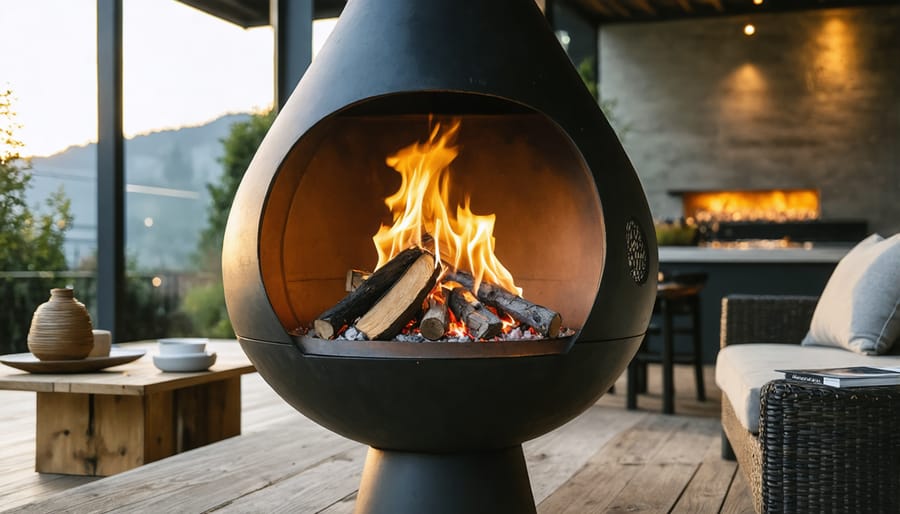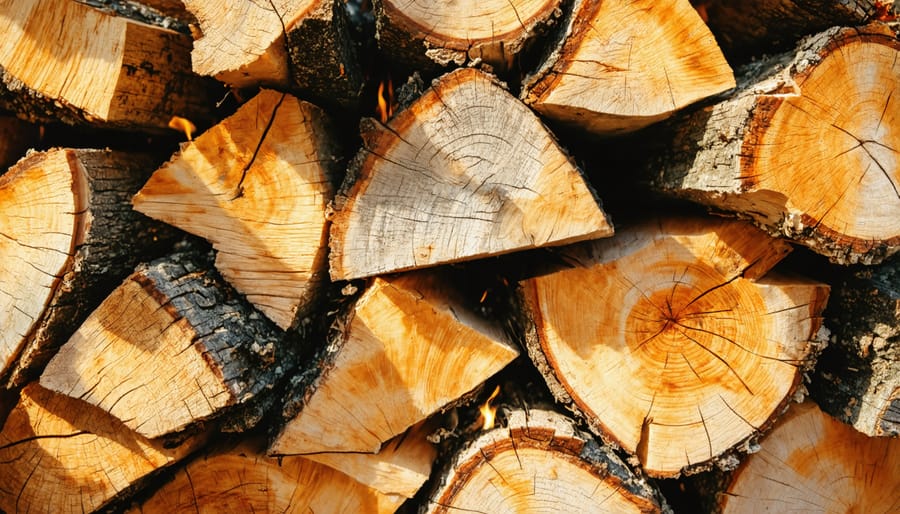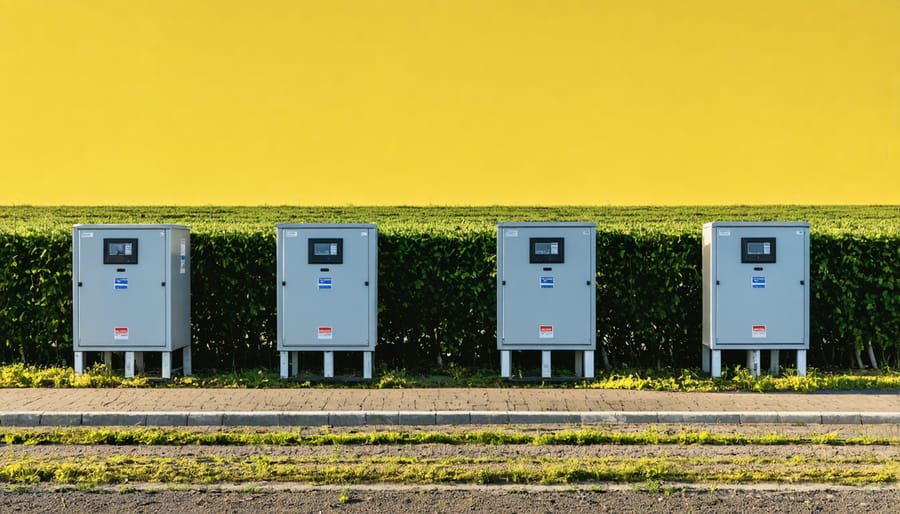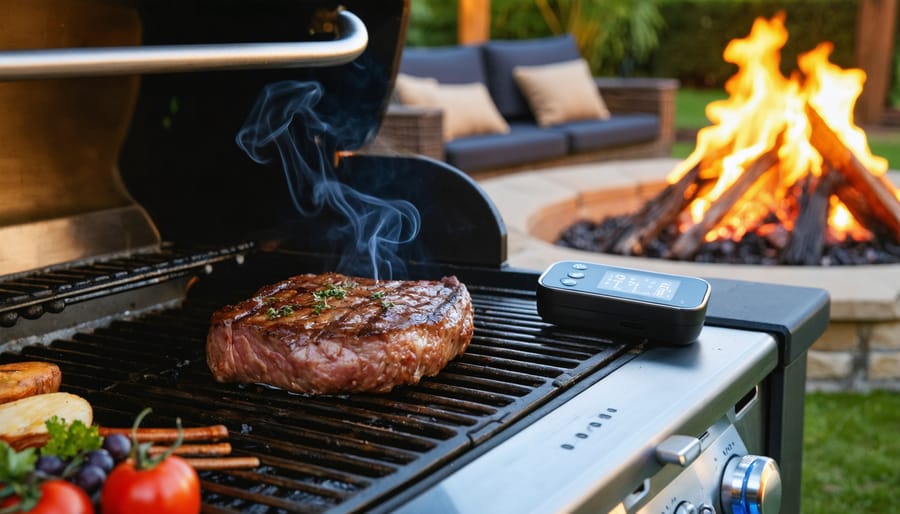Choose sustainably sourced wood or bioethanol fuel to minimize emissions while enjoying the distinctive charm of an outdoor chiminea fireplace. These clay or cast-iron vessels originate from Mexican tradition and offer a surprisingly eco-conscious alternative to conventional fire pits when used correctly.
Position your chiminea on a stable, non-flammable surface at least 10 feet from structures, using seasoned hardwood that burns cleaner and produces less smoke than softwood alternatives. Modern chimineas with proper ventilation systems can reduce particulate matter by up to 70% compared to open fire pits, making them a more neighbor-friendly choice for evening gatherings.
Consider models with removable ash drawers for easier cleaning and proper air circulation, which promotes complete combustion and fewer pollutants. The enclosed design naturally conserves fuel by focusing heat output, meaning you’ll burn less wood throughout the evening while creating an intimate gathering space that extends your outdoor season.
Maintain your chiminea with heat-resistant sealants for clay models or rust-preventive treatments for metal versions to ensure decades of use rather than replacement cycles. This investment in longevity aligns perfectly with sustainable living principles while transforming your patio into a warm, inviting retreat that honors both tradition and environmental responsibility.
What Makes a Chiminea Eco-Friendly (Or Not)
The Fuel Problem Most People Ignore
Here’s something most chiminea owners don’t think about until they’re standing in front of their fire pit, wondering why their eyes are watering or their neighbors are giving them looks: what you burn matters more than you might think.
Let’s talk about your fuel choices for outdoor heaters. Traditional wood burning creates that authentic crackling ambiance we all love, but it also releases particulate matter and carbon dioxide into the air. Hardwoods like oak and maple burn cleaner than softwoods, though they still contribute to your carbon footprint.
Charcoal offers convenience and consistent heat, but its production process is energy-intensive, and it emits more carbon monoxide than wood. Not exactly the eco-friendly choice many assume it to be.
Gas-powered chimineas dramatically reduce emissions compared to solid fuels. They produce minimal particulates and allow for precise temperature control, making them surprisingly efficient. The trade-off? You lose some of that rustic charm and the experience of tending a real fire.
Bioethanol represents the greenest option available. This renewable fuel burns clean, producing only water vapor and trace carbon dioxide with no smoke or ash. While it won’t give you that campfire smell, it delivers guilt-free warmth for environmentally conscious homeowners.
The bottom line: your fuel choice directly impacts both air quality and your environmental footprint. Understanding these differences helps you make informed decisions that align with your sustainability values while still enjoying outdoor comfort.
Material Matters: Clay vs. Cast Iron vs. Steel
Choosing the right material for your chiminea significantly impacts both its environmental footprint and longevity. Clay chimineas offer a traditional, natural option with minimal processing requirements, making their production relatively low-impact. However, they’re more fragile and may need replacing after a few seasons, especially in harsh climates. This shorter lifespan can offset their initial eco-friendliness.
Cast iron chimineas strike an impressive balance between durability and sustainability. While their production requires more energy, they can last decades with proper care, meaning fewer replacements over time. Plus, cast iron is highly recyclable at the end of its life, keeping materials in circulation rather than heading to landfills.
Steel chimineas, often the most affordable option, vary in their environmental impact depending on thickness and quality. Thinner steel models may rust quickly, requiring premature replacement. However, heavy-gauge steel versions rival cast iron’s longevity. Look for chimineas made with recycled steel content to reduce environmental impact.
The sustainability winner? It’s the chiminea you’ll use longest. A durable cast iron or quality steel model that serves your family for twenty years outweighs a cheaper option needing replacement every three years, regardless of initial production impact.
The Cleanest-Burning Chiminea Options for Your Backyard

Bioethanol Chimineas: The Modern Clean Solution
If you’re looking for the cleanest-burning option available, bioethanol chimineas represent the cutting edge of eco-friendly outdoor heating. These innovative fireplaces use denatured ethanol as fuel, producing a real flame without any smoke, ash, or harmful emissions—just water vapor and minimal carbon dioxide.
The benefits are compelling for environmentally conscious homeowners. Bioethanol burns completely clean, meaning no messy cleanup, no chimney maintenance, and no contribution to local air pollution. You can enjoy a beautiful, dancing flame without worrying about your carbon footprint or annoying your neighbors with smoke. They’re also incredibly portable and require no installation, making them perfect for renters or those who like rearranging their outdoor spaces.
However, there are some trade-offs to consider. Bioethanol chimineas produce less heat than wood-burning models—typically adequate for ambiance and taking the chill off a cool evening, but not for serious warmth on cold nights. The fuel cost is higher than wood or propane, though you’re paying for the convenience and environmental benefits. Most models also lack the traditional chiminea aesthetic, leaning toward contemporary designs that might not suit every style preference.
These modern chimineas work best for smaller patios where you want atmosphere without smoke, or for homeowners who prioritize sustainability and convenience over maximum heat output. They’re ideal lifestyle pieces that let you enjoy outdoor gatherings guilt-free, knowing you’re choosing the most environmentally responsible option available.
Propane and Natural Gas Models
If you’re an eco-conscious homeowner looking for the cleanest burning option, propane and natural gas chimineas deserve serious consideration. These modern alternatives offer a wonderful blend of convenience and environmental responsibility that traditional wood-burning models simply can’t match.
Gas-powered chimineas produce significantly fewer emissions than their wood-burning counterparts, making them an excellent choice for reducing your carbon footprint while still enjoying beautiful outdoor flames. You’ll appreciate how they eliminate smoke, ash, and particulate matter that can affect air quality in your neighborhood. This makes them particularly valuable in areas with air quality restrictions or where you want to be a considerate neighbor.
The control factor is truly impressive. With a simple turn of a knob or push of a button, you can adjust flame height and heat output precisely to your comfort level. No more waiting for wood to catch or dealing with unpredictable temperature fluctuations. This instant on-and-off capability means you’re only using fuel when you actually need it, maximizing efficiency and minimizing waste.
From a lifestyle perspective, gas chimineas free up your time for what matters most: relaxing with family and friends. There’s no hauling firewood, no constant tending, and no cleanup afterward. While the initial investment may be higher than traditional models, many homeowners find the convenience and environmental benefits well worth it. Plus, you’re choosing a heating solution that aligns with sustainable living principles without sacrificing the cozy ambiance that makes outdoor gatherings special.
EPA-Certified Wood-Burning Chimineas
Modern wood-burning chimineas have come a long way in reducing their environmental footprint. If you’re committed to burning wood while being mindful of air quality, look for EPA-certified models that meet strict emissions standards. These chimineas feature improved combustion technology that burns wood more completely, producing significantly less smoke and particulate matter than traditional designs.
When shopping, check for the EPA certification label, which guarantees the unit has been independently tested and meets federal clean air standards. These certified models typically incorporate features like secondary combustion chambers and optimized airflow systems that maximize heat output while minimizing harmful emissions. Many manufacturers now proudly display their EPA certification, making it easier for eco-conscious homeowners to make responsible choices.
Beyond the initial purchase, maintaining proper burning practices matters too. Use only seasoned hardwoods with low moisture content, avoid burning treated wood or trash, and always follow the manufacturer’s guidelines for curing your chiminea and ongoing maintenance. These simple steps ensure your wood-burning chiminea operates as cleanly and efficiently as designed, letting you enjoy cozy outdoor fires with a clearer conscience.
Pellet-Burning Options
If you’re looking for an even cleaner-burning option that combines convenience with sustainability, pellet-burning chimineas deserve your attention. These innovative designs use compressed wood or biomass pellets as fuel, offering impressive efficiency that transforms your outdoor space while treading lightly on the environment.
Pellet chimineas burn hotter and more completely than traditional wood models, producing minimal smoke and ash. The pellets themselves are often made from recycled sawdust and wood waste, giving new life to materials that would otherwise go unused. You’ll appreciate how easy they are to operate, with consistent heat output and less frequent refueling compared to cord wood. While they may require an initial investment in both the unit and pellet supply, many homeowners find the reduced emissions and hassle-free maintenance make them a worthwhile addition to their outdoor living setup, perfectly balancing modern convenience with environmental responsibility.
How to Use Your Chiminea Without Wrecking Your Carbon Footprint
Choosing the Right Fuel Every Time
The wood you choose for your chiminea makes all the difference in creating a clean, efficient fire that’s better for both the environment and your outdoor living experience. When selecting sustainable fuel, look for locally sourced hardwoods like oak, maple, or hickory from certified suppliers who practice responsible forestry.
Seasoned wood with a moisture content below 20% is your sweet spot. Well-dried wood burns hotter, produces less smoke, and creates minimal creosote buildup. You can test moisture levels with an inexpensive wood moisture meter, or simply look for wood that feels light, has visible cracks at the ends, and makes a hollow sound when pieces are knocked together.
Never burn treated lumber, painted wood, or construction scraps in your chiminea. These materials release toxic chemicals when burned, harming both air quality and your health. Similarly, avoid softwoods like pine for regular use, as they contain more resin that creates excessive smoke and sparks. By choosing the right fuel, you’ll enjoy longer-lasting fires with less environmental impact and a more pleasant atmosphere for everyone gathered around your chiminea.

The Perfect Fire: Less Smoke, More Heat
The secret to an efficient chiminea fire lies in your fuel choice and building technique. Start with well-seasoned hardwood that’s been dried for at least six months—properly seasoned wood burns hotter and produces significantly less smoke than green or wet wood. You’ll know it’s ready when you see cracks in the ends and hear a hollow sound when two pieces knock together.
Build your fire using the top-down method: place larger logs at the bottom, then medium-sized pieces, followed by kindling and small twigs at the top. Light from the top and let the fire burn downward. This technique creates a more complete combustion process, reducing smoke while generating consistent heat that radiates beautifully into your outdoor space.
Keep your fuel pieces small to medium-sized—about the thickness of your wrist works perfectly for most chimineas. Smaller pieces catch fire more easily and burn more completely, meaning you’re getting maximum warmth with minimal environmental impact. Avoid overloading your chiminea; a modest fire with good airflow outperforms a smoldering, overstuffed one every time. Remember, the goal is creating that perfect balance where your outdoor gathering stays cozy while your conscience stays clear.
Maintenance That Extends Lifespan
Investing in a quality chiminea is just the beginning—proper maintenance is what transforms it from a seasonal purchase into a longtime companion for your outdoor living space. Following the proper curing process sets the foundation, but ongoing care truly extends its lifespan.
Regular cleaning makes a significant difference. After each use, once your chiminea has completely cooled, remove ash and debris to prevent moisture buildup that can cause cracks or rust. For clay models, gently brush away residue without using harsh chemicals that might damage the finish.
Weatherproofing is essential between uses. Apply a waterproof sealant to clay chimineas annually, and cover all types with breathable, weather-resistant covers when not in use. This simple step prevents weather damage that accounts for most premature replacements.
Seasonal storage deserves attention too. During harsh winter months or extended periods of non-use, store your chiminea in a dry, protected area like a garage or shed. If that’s not possible, elevate it off the ground and ensure your cover fits snugly to keep moisture out.
These straightforward maintenance habits can double or even triple your chiminea’s lifespan, making it a more sustainable choice while protecting your investment.
Smart Placement and Design for Maximum Efficiency
Getting the most from your outdoor chiminea starts with smart positioning. Think of your chiminea as the heart of your outdoor living space, and you’ll want to place it where it naturally gathers people while working efficiently.
For optimal heat distribution, position your chiminea in a corner or against a wall that can reflect warmth back toward seating areas. This simple trick can reduce fuel consumption by up to 30% compared to placing it in an open space where heat disperses in all directions. Natural windbreaks like fences, hedges, or your home’s exterior walls protect the flame from gusts that steal heat and make your chiminea work harder.
When considering safe chiminea placement, maintain at least 10 feet of clearance from structures, overhanging branches, and any flammable materials. A stable, non-combustible base is essential for both safety and efficiency. Level ground prevents uneven burning that wastes fuel and creates unnecessary smoke.
Creating an intimate outdoor space naturally requires less heating. Consider using outdoor rugs, weather-resistant cushions, and strategic furniture placement to define cozy zones that trap warmth. Low walls, potted plants, or decorative screens can help contain heat without blocking the welcoming glow of your chiminea.
Pay attention to prevailing wind patterns in your yard. Position the opening away from your primary seating area to prevent smoke intrusion while still allowing everyone to enjoy the warmth. If you live in a windy area, a chiminea with a taller chimney and smaller opening will burn more efficiently than wide-mouth designs.
Remember, the goal is creating a comfortable outdoor retreat that extends your living space while using minimal fuel and maximizing the natural charm that makes chimineas such wonderful lifestyle additions.

When a Chiminea Isn’t the Answer
While chimineas offer wonderful ambiance and eco-friendly heating, they’re not always the perfect fit for every outdoor space or lifestyle. Being honest about this helps you make the best choice for your home.
If you’re looking to heat a large patio or deck area, a chiminea’s focused heat output might leave guests on the edges feeling chilly. In these situations, modern propane or natural gas patio heaters can provide more even heat distribution across wider spaces. While they use fossil fuels, newer models operate with impressive efficiency and can be the practical choice for entertaining larger groups.
Fire tables present another compelling alternative, especially if you love the idea of gathering around flames but need surface space for drinks and appetizers. These dual-purpose pieces combine the cozy ambiance of fire with functionality that chimineas simply can’t match.
For those who prefer versatility in placement, portable fire pits offer flexibility that traditional chimineas don’t. You can easily move them around your yard for different occasions, and many contemporary designs burn quite cleanly with the right fuel choices.
Safety considerations matter too. If you have very young children or pets who might accidentally touch or knock over a freestanding unit, built-in fire features or wall-mounted heaters might bring more peace of mind.
The key is matching your heating solution to your specific situation. Chimineas shine in intimate settings where their charming presence and focused warmth create magic, but sometimes your space and needs call for a different approach to outdoor comfort.
Creating a beautiful outdoor gathering space doesn’t mean you have to compromise on your environmental values. The good news is that chimineas can be both stunning focal points and responsible heating choices when you make informed decisions. Whether you’re evaluating your current setup or shopping for a new outdoor fireplace, you have the power to minimize your carbon footprint while maximizing warmth and ambiance.
Take a moment to consider your fuel choices, maintenance habits, and how your chiminea fits into your broader commitment to sustainable living. Small changes like switching to properly seasoned hardwood or exploring bioethanol options can make a meaningful difference. Remember, every conscious choice you make contributes to cleaner air and a healthier planet.
So go ahead and create that cozy outdoor retreat you’ve been dreaming about. With the right approach, you can enjoy crackling fires under the stars while staying true to your eco-friendly values. Your outdoor space can be both inviting and environmentally responsible, proving that comfort and consciousness go hand in hand.






